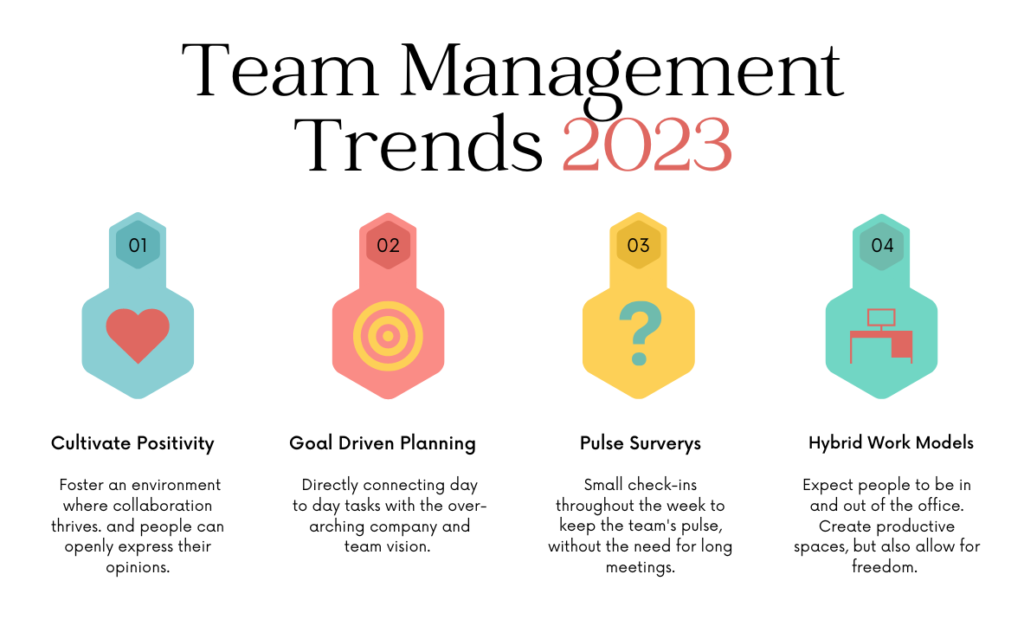2022 saw alot of major changes in workplace culture from previous years as a slow return to “normalcy” took place. Of course it was much less of a return to the old, but more of an evolution. One of the biggest changes was a large push for companies to create a more united and positive environment both in offices and virtual spaces as a way to increase engagement which had struggled in the years prior.
This push for building team engagement is expected to continue into 2023. Under this umbrella of engagement we expect to see four major trends:
- Efforts to create more positive team and work enviornments.
- Using goals and objectives to make sure that each team member feels like the push the team forward.
- Pulse Surveys and other small check-ins to make sure people are engaged, but also for leaders to engage with their teams.
- Hybrid work models where people alternate between office and digital work.

Let’s take a look at the trends expected to take center stage in the coming year, as well as how you can practically implement these ideas in the coming months to create a more engaged team.
1. The Do’s and Don’ts of Cultivating a Positive Team Environment
Do:
Provide clear and consistent communication to your team members. Regularly communicate expectations, goals, and successes with the entire team in order to build a sense of camaraderie and trust.
Don’t:
Discourage collaboration within the team by creating a competitive atmosphere where individual accomplishments are prioritized over collective success. Furthermore, avoid micromanaging tasks as this can be detrimental to employee morale and motivation. Lastly, never forget to give credit where credit is due; recognizing employees for their contributions will go a long way in fostering an engaged work culture.
Do:
Ask alot of questions. The best way to see where your team is by asking. Be sure to keep these questions productive and use tools and software to keep track of responses. Additionally, ensure that any feedback is constructive and respectful so as not to create an environment of discouragement or tension.
Don’t:
Forget the teams goals. Having clear goals and objectives for the team is important to make sure that everyone is moving together. Take time every week to assess how the goals are progressing, and at least once a month take a deeper look. If things are going off track it is time to stop and reflect on your actions or the goals themselves.
Learn more on how to set SMART Goals here.
2. How to Use Goal Driven Planning to Boost Engagement
Quarterly goal setting is a powerful tool that can be used to boost employee engagement in the workplace. By regularly setting and reviewing team goals, managers are able to keep performance standards high while still allowing employees to feel empowered and motivated by their achievements.
Additionally, quarterly goal setting allows for ongoing feedback from all levels of staff which creates an open dialogue between management and employees. This process also encourages transparency, as it ensures everyone understands how their individual efforts contribute towards achieving overall organizational objectives.
As a result, this practice helps foster a sense of unity among team members who recognise the importance of working together towards common goals. Ultimately, when effectively executed, quarterly goal setting has the potential to create an engaged work environment where each member truly feels part of something larger than themselves.
While setting goals is great, the next step is making sure those goals see actions taken towards them, checking in each week is the best way to make sure that happens. Tools like Team Compass can help with the check-in and goal planning process.
3. The Importance of Weekly Pulse Surveys for Team Engagement
Weekly pulse surveys are an important tool for measuring employee engagement and ensuring teams stay connected. These short surveys provide a snapshot of the team’s overall sentiment and can be used to identify areas for improvement or celebrate successes.
By regularly collecting feedback, managers can more accurately gauge how employees feel about their roles within the organization, enabling them to make data-driven decisions that will ultimately result in increased job satisfaction and higher levels of engagement from staff.

Additionally, weekly pulse surveys offer employees an opportunity to voice their opinions in a safe space where they know their thoughts will be heard and valued. This encourages trust between management and staff, as well as creates a sense of transparency which helps build strong relationships among team members.
Ultimately, when effectively implemented into any organization’s culture, weekly pulse surveys have the potential to drive up engagement levels by creating an environment where everyone feels supported and respected regardless of rank or position.
Questions to Ask Your Team during Weekly Meetings
One of the most effective ways to improve team engagement is to ensure that everyone’s voice is heard during weekly meetings. Asking pertinent questions can help create a space in which all members feel comfortable expressing their opinions and ideas, and ultimately foster an environment where collaboration thrives. When selecting questions for your weekly meetings, it is important to consider both the individual needs of each team member as well as the overall objectives of the organization.
For example, asking employees about their progress on specific tasks or projects can provide invaluable insight into how effectively they are working towards organizational goals. Additionally, inquiring about any obstacles facing staff can be beneficial for identifying areas that need improvement within the workplace culture or processes.
Finally, open-ended questions such as “What was your proudest moment this week?” or “How do you think we could better work together as a team?” serve to ignite conversations and encourage creative problem solving among staff members. Ultimately, when used strategically in weekly meetings with your team, these types of questions have the potential to increase employee engagement by creating an atmosphere that values input from all levels of management and encourages collaboration across departments.
Here’s an ordered list of questions you can use to kick off your team meetings:
- What accomplishments have you made last week?
- What plans do you currently have?
- Have you face any issues with your existing plans?
- How is your energy this week?
- Is there anything you need help with?
See more example of questions to ask your team in meetings here.
4. Hybrid Work Models
A hybrid work model combines elements of remote and traditional workplace settings in order to increase efficiency and productivity for employees. In this blog, we will explore what exactly constitutes a hybrid work model, analyze its advantages and disadvantages, discuss how to effectively implement it with your team and address why it has become a viable option for many organizations.

Hybrid work models are an innovative approach to combining elements of both remote and traditional workplace settings in order to maximize efficiency and productivity for employees. This type of model allows organizations to embrace the advantages of remote work while still maintaining the benefits that come with having a physical office space. In hybrid models, employees can be given the flexibility to choose how they want to spend their time working – either remotely or at an on-site location.
It is also essential for employers to be flexible in terms of allowing employees different ways of getting work done depending on their individual preferences – whether it be through virtual meetings or by providing extra equipment if needed – so that no one feels hindered due to limited resources or lack of physical interaction at times.
Lastly, organizations must foster an open dialogue between colleagues regardless of where they are located so that all stakeholders feel included within the workplace environment despite any geographical boundaries .
Use a Team Engagement Tool
In today’s increasingly competitive marketplaces, companies who invest in employee engagement reap significant rewards over those that do not prioritize this aspect of their business operations. A variety of tools and software can easily hope you build a more engaged team.
Team Compass helps you measure employee happiness and team satisfaction to ensure that everyone is content with their job. With the intuitive and easy-to-use interface, you can easily create and track goals, review progress, assign tasks, and measure team satisfaction. Team Compass provides you with the perfect tool-kit to lead your team to success.

By providing support systems such as regular performance reviews and feedback loops, employers can ensure that employees stay motivated and satisfied with their roles at the company while also encouraging creative problem-solving skills which can help drive growth for any organization.
2023 and beyond
2023 is expected to show us the importance of creating an engaging team environment that fosters collaboration and growth. While which trends will become cemented in work-place culture for years to come is still yet to be seen, for certain a team that is engaged brings myriad of benefits including improved communication, decision making, productivity, and creativity.
Investing in building an engaging work environment for your team, whether through new practices or tools like Team Compass, will help transform it into a strong cohesive unit in which everyone works together towards a common objective.